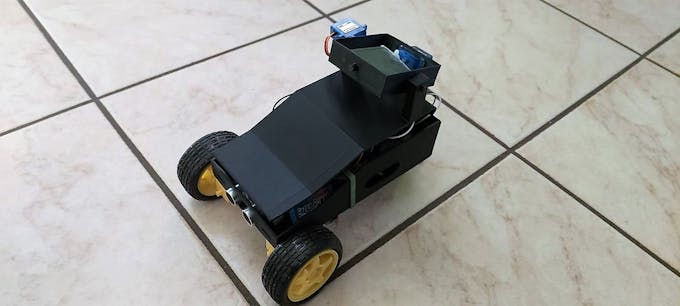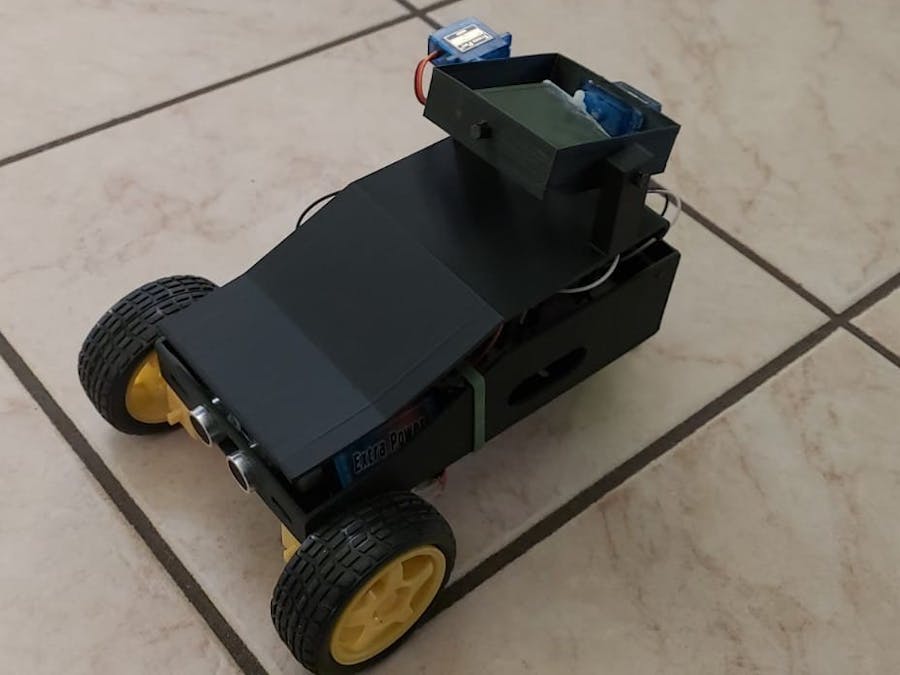Pluto Bluetooth RC Car
Pluto Bluetooth RC Car © LGPL
Pluto is a 2WD bluetooth car on which is placed a self balancing plane.
COMPONENTS AND SUPPLIES
 Arduino IDEUltimaker CuraSolidWorks 2019/20
Arduino IDEUltimaker CuraSolidWorks 2019/20
ABOUT THIS PROJECT

Pluto is a project about a particular bluetooth machine.
This car can be controlled by a mobile phone, connecting the car on the Bluetooth we have used the app Arduino Bluetooth Controller which can be found on the Play Store.

On it are installed a self balancing platform composed of two floors connected to two servomotors, which keep the horizontal plane, by means of an accelerometer, which calculates the angle and sends the same values to the servomotors, but opposite.
We decided to do this project for two reasons: 1 have a child play; 2 to be able to bring a glass to a person without emptying it if there are ramps.
The operation is simple: sending a bluetooth signal from the phone the arduino card detects it and makes the machine move left, right, forward, backward or stand still based on what we want it to do to it.
For the self balancing plane it stabilizes independently thanks to the two servomotors, the accelerometer and the gyroscope (mpu6050).
CODE
Pluto car codeArduino
char t;
#include <Wire.h> //include the required libraries
#include <MPU6050.h> //include MPU6050 libraries
#include <Servo.h>
MPU6050 sensor ; //create an instance of the MPU6050 named sensor
Servo sg90y;
Servo sg90x;
int servo_pinX = 2;
int servo_pinY = 3;
int motor1A = 4;
int motor1B = 5;
int motor2A = 6;
int motor2B = 7;
int16_t ax, ay, az ; //declare 6 16 bit integer variables
int16_t gx, gy, gz ; //declare 6 16 bit integer variables
void setup() {
pinMode(servo_pinX, OUTPUT);
pinMode(servo_pinY, OUTPUT);
pinMode(motor1A, OUTPUT);
pinMode(motor1B, OUTPUT);
pinMode(motor2A, OUTPUT);
pinMode(motor2B, OUTPUT);
pinMode(A5, INPUT);
pinMode(A4, INPUT);
sg90x.attach ( servo_pinX );
sg90y.attach ( servo_pinY );
Wire.begin ( ); //begins the trasmission with MPU6050
sensor.initialize ( ); //initialise the sensor
Serial.begin(9600);
delay(400);
}
void forward() {
digitalWrite(motor1A, LOW);
digitalWrite(motor1B, HIGH);
digitalWrite(motor2A, LOW);
digitalWrite(motor2B, HIGH);
}
void reverse() {
digitalWrite(motor1A, HIGH);
digitalWrite(motor1B, LOW);
digitalWrite(motor2B, LOW);
digitalWrite(motor2A, HIGH);
}
void right() {
digitalWrite(motor1B, HIGH);
digitalWrite(motor1A, LOW);
digitalWrite(motor2B, LOW);
digitalWrite(motor2A, HIGH);
}
void left() {
digitalWrite(motor1B, LOW);
digitalWrite(motor1A, HIGH);
digitalWrite(motor2B, HIGH);
digitalWrite(motor2A, LOW);
}
void nomove() {
digitalWrite(motor1B, LOW);
digitalWrite(motor1A, LOW);
digitalWrite(motor2B, LOW);
digitalWrite(motor2A, LOW);
}
void loop() {
sensor.getMotion6 (&ax, &ay, &az, &gx, &gy, &gz); //read 6 values into 6 variables
ay = map (ay, -17000, 17000, 0, 180) ; // change the range of the ay value from -17000/17000 to 0/180
sg90y.write (ay);
ax = map (ax, -17000, 17000, 0, 180) ; // change the range of the ax value from -17000/17000 to 0/180
sg90x.write (ax);
if (Serial.available()) {
t = Serial.read();
Serial.println(t); //Read the incoming data and store it into variable t
if (t == 'F') {
forward();
}
else if (t == 'B') {
reverse();
}
else if (t == 'L') {
left();
}
else if (t == 'R') {
right();
}
else if (t == 'S') {
nomove();
}
}
}
- Comments(0)
- Likes(1)





















